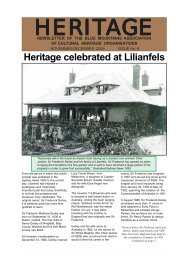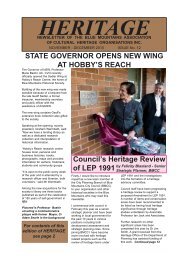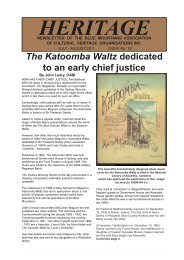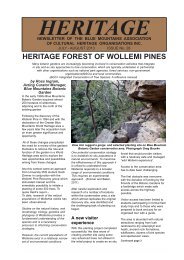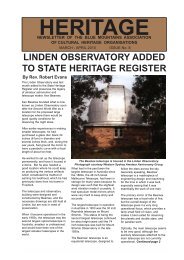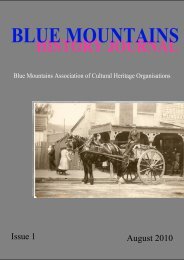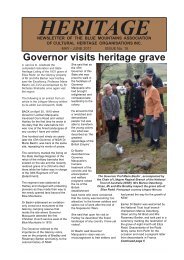Blue Mountains History Journal Issue 2
Blue Mountains History Journal Issue 2
Blue Mountains History Journal Issue 2
Create successful ePaper yourself
Turn your PDF publications into a flip-book with our unique Google optimized e-Paper software.
<strong>Blue</strong> <strong>Mountains</strong> <strong>History</strong> <strong>Journal</strong> 2; 2011<br />
A HISTORY OF THE POSTAL AND TELEPHONE SERVICES TO MOUNT WILSON<br />
Mary Reynolds<br />
Donna Buang, Church Lane, Mount Wilson, NSW 2786<br />
mary_reynolds@internode.on.net<br />
Abstract<br />
Mt. Wilson was settled in 1875 but not until 1879 was a Receiving Officer for mail appointed at the<br />
nearest railway platform at Bell, from whom Mt. Wilson residents had to collect their mail. From the<br />
start of 1889 a contractor carried the mail from Bell to Mt. Wilson and in 1890 delivery commenced<br />
to a Post Office in the grounds of Beowang where a Telephone Exchange was installed in 1916.<br />
Eventually a dedicated Post Office building was erected adjacent to St George’s Church in 1922 and<br />
it functioned until 1986 with only a manual telephone exchange. Then all services were transferred to<br />
Mt. Victoria from which mail had to be delivered to individual properties in Mt. Wilson and Mt. Irvine.<br />
Key Words: Mt. Wilson, Post Office, Telephone, Beowang, <strong>Blue</strong> <strong>Mountains</strong>.<br />
Introduction<br />
Even in the twenty-first century, Mt. Wilson and Mt. Irvine remain rather isolated, yet separate,<br />
settlements in the northern <strong>Blue</strong> <strong>Mountains</strong> or the Carmarthen Hills as Governor Arthur Phillip described<br />
them (on 5 July 1789 when exploring the Hawkesbury; Valder 1988, p.65). Both mountains are on the<br />
same ridge and are surrounded by The World Heritage <strong>Blue</strong> <strong>Mountains</strong> National Park and the Wollemi<br />
National Park. They are capped by basalt which produces a rich dark soil and in the times of the<br />
indigenous occupants it carried a temperate rain forest of coachwood, sassafras and an understorey of<br />
magnificent tree ferns. Mt. Wilson, which lies above 1000 metres, today has fine gardens, shaded<br />
avenues and reserves on that rich soil and experiences a moist, cool climate; Mt. Irvine is lower, but<br />
still above 800 metres, and it too has its share of splendid gardens along with its traditional rural heritage.<br />
In 1875-1876 when Mt. Wilson was first settled by Europeans they<br />
created rough tracks, so an effective means of communication<br />
would have seemed to us impossible. Mt. Wilson was a ‘Hill<br />
Station’ providing a cool summer, due to its 1000 metre altitude,<br />
and a healthy isolated environment of rich volcanic soil and<br />
vegetation. Such features attracted a small number of wealthy<br />
members of NSW Society to build a summer home on this<br />
mountain. In 1999 I was fortunate to be able to access the records<br />
of postal service to Mt. Wilson and Bell and discovered a detailed,<br />
if at times laboured, story of persistent efforts to establish a<br />
permanent postal service for Mt. Wilson. Being settled 20 years<br />
later in 1897, Mt. Irvine was not involved (Naylor & Scrivener<br />
1997, pp.1, 7, 13-14).<br />
Figure 1. Map of Mount Wilson<br />
showing most of the houses in<br />
this paper (Stanton & Sons Ltd<br />
1935a).<br />
E.S. Wyndham surveyed north from Mt. Victoria along the Darling<br />
Causeway, then southeast to the Mt. Wilson turnoff, along what<br />
we now know as Bells Line of Road, and finally the eight km (5<br />
miles) into Mt. Wilson. He made clear to Surveyor General Phillip<br />
Francis Adams, that a railway platform should be built alongside<br />
the existing line to Lithgow to provide reasonable access to the<br />
land that he had surveyed at Mt. Wilson 16 km away (10 miles -<br />
Currey 1968, p.75). His plea was successful and the Mt. Wilson<br />
Platform was opened on 5 May 1875 (Currey 1968, p.30), but<br />
following the suggestion of G.H. Cox (Cox 1888) it was renamed<br />
Bell on 1 May 1889 (Wylie & Singleton 1958, p.93; note that letter<br />
B89/852 in NAA (1876-1917) records the change of name date as<br />
30 May 1889).<br />
37 Back to Contents




